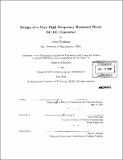Design of a very high frequency resonant boost DC-DC converter
Author(s)
Burkhart, Justin (Justin Michael)
DownloadFull printable version (17.02Mb)
Alternative title
Design of a very high frequency resonant boost direct current-direct current converter
Other Contributors
Massachusetts Institute of Technology. Dept. of Electrical Engineering and Computer Science.
Advisor
David Perreault.
Terms of use
Metadata
Show full item recordAbstract
THIS thesis explores the development of a very high frequency DC-DC resonant boost converter. The topology examined features low parts count and fast transient response but suffers from higher device stresses compared to other topologies that use a larger number of passive components. A new design methodology for the proposed converter topology is developed. This design procedure - unlike previous design methodologies for similar topologies - is based on direct analysis of the topology and does not rely on lengthy time-domain simulation sweeps across circuit parameters to identify good designs. Additionally, a method to design semiconductor devices that are suitable for use in the proposed VHF power converter is presented. When the main semiconductor switch is fabricated in a integrated power process where the designer has control over the device layout, large performance gains can be achieved by considering parasitics and loss mechanisms that are important to operation at VHF when designing the device. A method to find the optimal device for a particular converter design is presented. The new design methodology is combined with the device optimization technique to enable the designer to rapidly find the optimal combination of converter and device design for a given specification. To validate the proposed converter topology, design methodology, and device optimization, a 75 MHz prototype converter is designed and experimentally demonstrated. The performance of the prototype closely matches that predicted by the design procedure, and achieves good efficiency over a wide input voltage range.
Description
Thesis (S.M.)--Massachusetts Institute of Technology, Dept. of Electrical Engineering and Computer Science, 2010. Includes bibliographical references (p. 163-164).
Date issued
2010Department
Massachusetts Institute of Technology. Department of Electrical Engineering and Computer SciencePublisher
Massachusetts Institute of Technology
Keywords
Electrical Engineering and Computer Science.